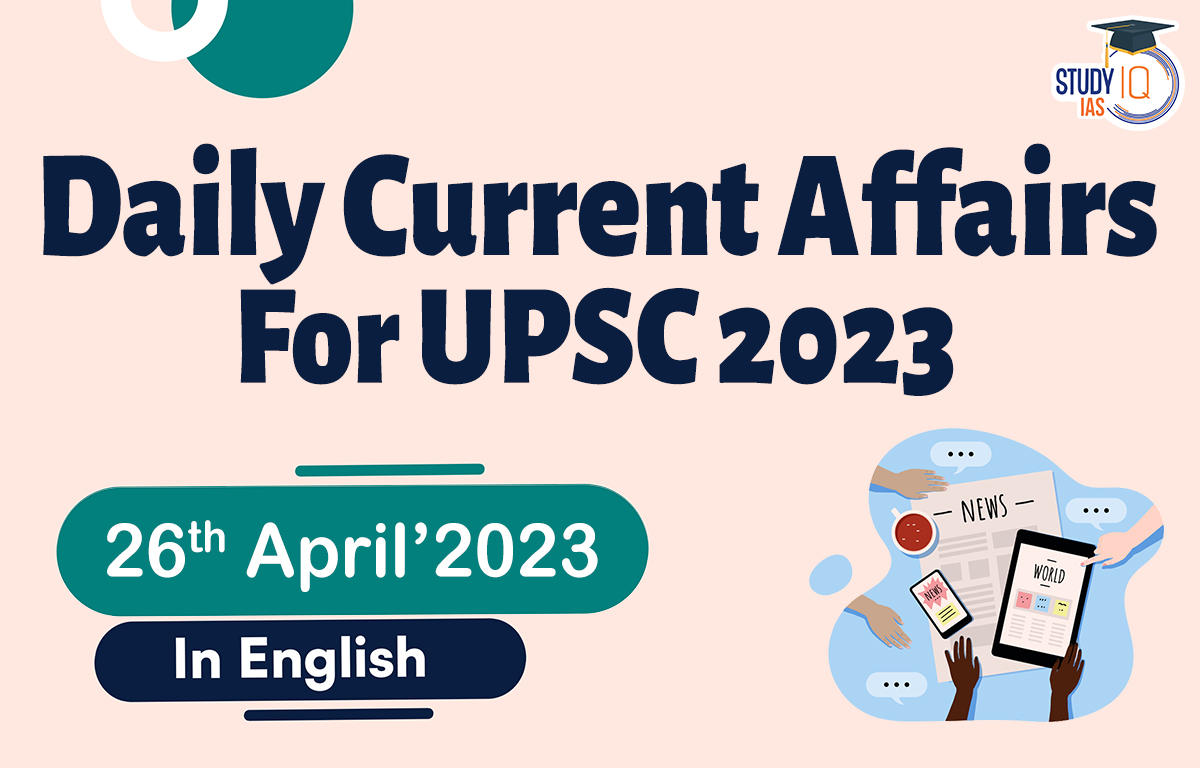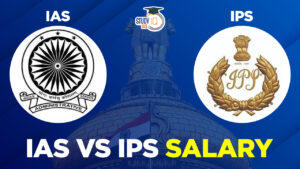Daily Current Affairs for UPSC 2023
Q) Recently seen in news, the ‘Rule of law Index’ was released by which one of the following organization?
- World Justice Project
- World Economic Forum
- Varieties of Democracy institute
- Institute for Economics and peace
Daily Current Affairs for UPSC – 25 April 2023
Explanation:
- Option (1) is correct: World Justice Project (WJP) measures people’s perceptions and experiences of the rule of law in 140 countries and jurisdictions in the Rule of law Index. Index values range between 0 and 1 with 1 being the score for complete adherence to the rule of law. India’s overall score in the 2022 report is 0.5 and its global rank was 77 out of 140 countries. Indicator Used for Rule of law Index by WJP
- Constraints on government powers: This includes things like how effectively does the legislature or the judiciary deals with the government.
- Absence of corruption: This essentially ascertains if public offices are being used for private gains.
- Open Government: This includes things such as the right to information and laws and government data, which are well publicised.
- Fundamental rights: This also includes whether the due process was followed.
- Order and security: Whether crime is effectively controlled and civil conflict limited etc.
- Regulatory enforcement: Things like whether regulations are effectively enforced etc.
- Civil justice: Includes factors such as whether people can afford and access civil justice,
- Criminal justice: Includes factors such as whether due procedures are followed etc.
Q) With reference to ‘Genome Sequencing’, consider the following statements:
- A Genome is the entire set of genetic material or DNA.
- The whole genome shotgun sequencing method is used frequently for larger eukaryotic genomes.
- Genetic variations that influence a person’s response to particular drugs can be found through genomic sequencing.
Which of the statements given above is/are correct?
- 1 and 2 only
- 1 and 3 only
- 2 and 3 only
- 1, 2 and 3
Explanation:
- Statement 1 is correct: A genome is all of the genetic material in an organism. It is made of DNA (or RNA in some viruses) and includes genes and other elements that control the activity of those genes. Genome is the entire set of genetic material or DNA, while gene is a specific segment of DNA that codes for a particular protein or RNA molecule. The human genome is the entire set of deoxyribonucleic acid (DNA) residing in the nucleus of every cell of each human body. The DNA consists of a double-stranded molecule built up by four bases – adenine (A), cytosine (C), guanine (G) and thymine (T). Every base on one strand pairs with a complementary base on the other strand (A with T and C with G). In all, the genome is made up of approximately 3.05 billion such base pairs.
- Statement 2 is incorrect: The clone-by-clone method involves constructing a physical map of the genome by cutting the DNA into small fragments, cloning these fragments into bacterial or yeast artificial chromosomes (BACs or YACs), and then mapping the location of each fragment within the genome. It works well for larger genomes like eukaryotic genomes but it requires a high-density genome map. The whole genome shotgun sequencing method involves randomly fragmenting the genome into small pieces, sequencing each piece, and then using computational algorithms to assemble the sequences into a complete genome. It is a faster method of sequencing but is not suitable for larger genomes like eukaryotic genomes as they have a number of repetitive DNA sequences in which the assembling process is challenging.
- Statement 3 is correct: The Department of Biotechnology recently said that the exercise to sequence 10,000 Indian human genomes and create a database under the Centre-backed Genome India Project is about two-thirds complete. During the COVID-19 pandemic, genomic sequencing helped to identify the virus, track its spread, identify new variants, understand how the virus spreads, and develop vaccines. Genomic sequencing can identify genetic variants that affect an individual’s response to certain medications.
Q) Consider the following statements about Misinformation Combat Alliance (MCA):
- It is an alliance set up by the Group of 20 to develop fact-checking tools.
- Only those organizations can apply for membership in the MCA that are recognized under the Companies Act of 2013.
Which of the statements given above is/are correct?
- 1 only
- 2 only
- Both 1 and 2
- Neither 1 nor 2
Explanation:
- Statements 1 and 2 are incorrect: Misinformation Combat Alliance’s (MCA) is an alliance of media companies set up in March 2022 to combat misinformation and build tools to aid fact-checking. Membership in the MCA is open to any organization that applies. It is currently a network of 14 digital publishers which includes publications such as Boom Live, Factly, The Logical Indian, Vishwas News and The Quint. The Misinformation Combat Alliance has approached the government to act as a self-regulating body to flag fake news online in line with the IT Rules, 2021. MCA’s proposal is to regulate misinformation that is unrelated to the Union government, which is reportedly due to the Centre’s unwillingness to hand this mandate to an international network like the International Fact Checking Network (IFCN). Central government has given it nod to the Misinformation Combat Alliance’s (MCA) proposal to set up a self-regulatory organization (SRO) to vet fact-checkers for non-government-related news.
Q) With reference to Urea, consider the following statements:
- India is both the second-largest consumer and producer of urea in the world.
- The urea subsidy is directly transferred to the farmer’s account by the government.
- Under the nutrient-based subsidy regime, the amount of subsidy is fixed by the state government as per the demand for fertilizers.
Which of the statements given above is/are not correct?
- 1 and 2 only
- 2 and 3 only
- 3 only
- 1, 2 and 3
Explanation:
- Statement 1 is incorrect: Urea is chemical nitrogen (N) fertiliser, white in colour, which artificially provides nitrogen, a major nutrient required by plants. India is the second-largest consumer and the third-largest producer of urea in the world. India consumes around 33 million tonnes of urea annually, of which almost 70% is domestically produced and the rest is imported from other countries. Most farmers prefer urea as fertilizer in India because other non-urea varieties like Di-Ammonium Phosphate (DAP), Muriate of Potash (MOP) etc. are expensive.
- Statement 2 is incorrect: In March 2018, the government implemented a decision requiring retailers to generate an Aadhaar authenticated invoice and sale being registered on a point-of-sale (PoS) machine. The manufacturers of the Urea were to get the Subsidy only on submission of this electronic proof of sale. In August 2020, the Centre restricted purchase of urea to 100 bags per transaction, down from 999 bags. It also wanted states to cap the number of such transactions by a purchaser in a month. The government now wants to cap the number of bags of subsidized fertilisers that a farmer can buy for the whole season. This cap is to be calculated based on the nutrient requirement linked to land holding, crops grown, etc.
- Statement 3 is incorrect: Under Nutrient-Based Subsidy (NBS) the central government fixed a per-kg subsidy for each fertiliser nutrient: Nitrogen (N), phosphorus (P), potash (K) and sulphur (S). In 2015, the Centre directed all manufacturers and importers to do neem-coating of the urea supplies. The underlying premise was that this would render urea unusable for industrial purposes and hence, diversion would be curbed.
Q) Consider the following statements about the Code on Social Security:
- As per the code, both contractual labour and gig workers are included in the definition of employee.
- The platform workers are provided with labour rights under the code.
- The provisions of social security are also extended to agricultural workers for the first time under the code.
Which of the statements given above is/are correct?
- 1 only
- 1 and 2 only
- 1 and 3 only
- 2 and 3 only
- Statement 1 is correct: The Code on Social Security in India aims to streamline and simplify the social security system in India. It rationalizes the provisions of eight existing central labour laws and attempts to include informal workers within the ambit of social security administration. It replaces nine existing social security laws. Of these, Employees Provident Fund (EPF), Employees State Insurance (ESI), maternity benefit and gratuity are entirely for organized sector workers. The definition of ‘employees’ will include contractual labour, gig workers, platform workers, labour from construction sites and most importantly interstate migrant labour.
- Statement 2 is incorrect: The new labour codes passed by Parliament acknowledge platform and gig workers as new occupational categories. The Code on Social Security allows platform workers to claim benefits, but not labour rights.
- Statement 3 is correct: The central government can apply the Code to any establishment (subject to size-threshold). The National Social Security Board may also act as the Board for the purposes of welfare of gig workers and platform workers and can recommend and monitor schemes for gig workers and platform workers. For the first time, provisions of social security will also be extended to agricultural workers also.


 IAS vs IPS Salary, Structure and Compari...
IAS vs IPS Salary, Structure and Compari...
 National Clean Air Programme, Key Featur...
National Clean Air Programme, Key Featur...
 Current Affairs 25th April 2024 for UPSC...
Current Affairs 25th April 2024 for UPSC...

















